Ah, eternal love. In the end, what you believe becomes your world. (Portrait of Jennie and Somewhere in Time)
Does your heart soar when you discover romantic fantasy stories that transcend the boundaries of time? Mine does if they meet the mysterious, fantastical, vaguely plausible criteria that I require in a well-told tale of love with timeless fluidity. What mechanisms drive the transfer? Is the tale magical? Passionate? Haunting? Spiritual? Does it ignite the imagination? Will love survive despite the odds, which are often insurmountable? The thought of love everlasting is grand, and that resonates with us unabashed romantics.
Nostalgia’s Pull
Let’s go back in time a bit to Politikens Boghal bookstore in Copenhagen on the edge of Tivoli Gardens. I bought a postcard there that echoed my philosophy: “I don’t live in the past, but the past lives in me.” As a historian who has delved into how and why the past affects the present and the future, I regard the enigmatic universe with wonder. The “what ifs” of the sliding door aspect of alternate scenarios create all sorts of possibilities.
Nostalgia’s pull has always been strong for me. Author Kate Morton in The Distant Hours memorably offered the view that nostalgia, or desire for things past, is an acute aching, “a yearning of the most profound kind: an awareness that time’s passage could not be stopped and there was no going back to reclaim a moment or a person to do things differently.” But what if this were not actually the case? What if clocks and calendars could be tossed aside and actual change initiated? Why not?
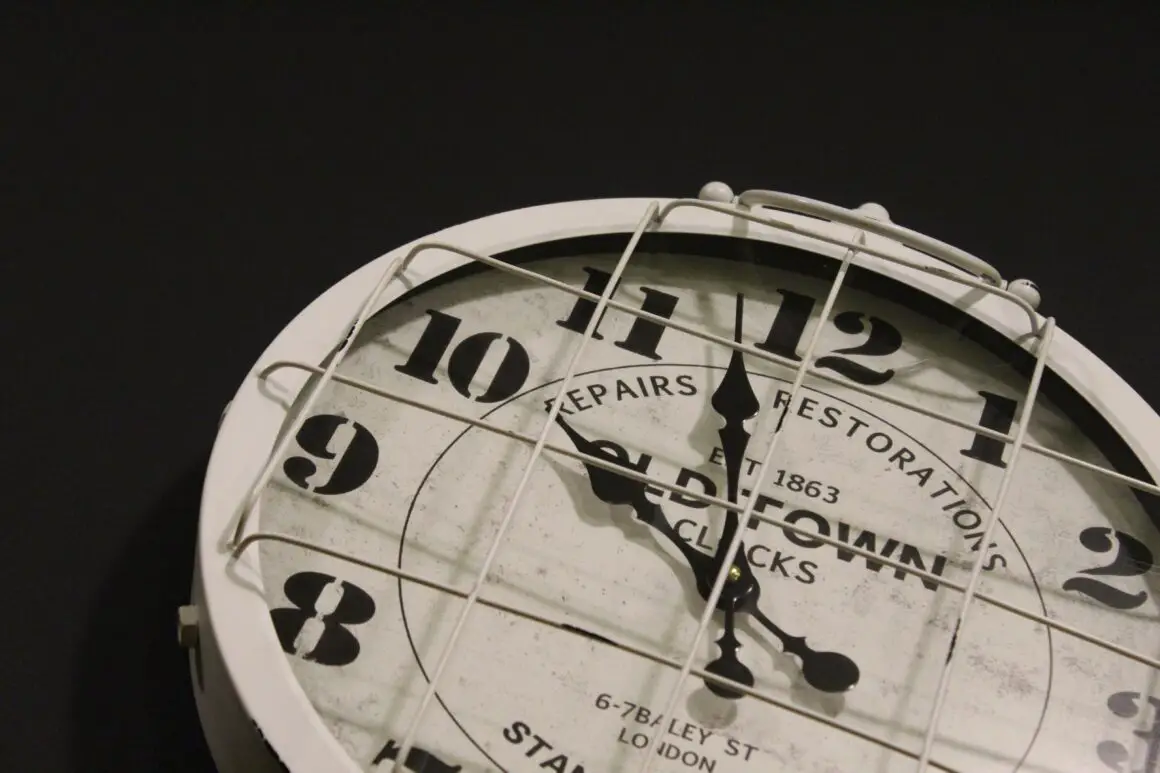
The puzzle about time’s boundaries has kept philosophers debating, scientists speculating, and enthusiasts hoping that it might be so for centuries. Different theories include three levels of time, manipulating alternate tracks of time, points of entry, mathematical equations, and a subtle division into a second universe from the original so that changes go unnoticed. Know that unpredictability of time and ensuing events get in the way of successful adaptation, and often plans go awry. Herein lies the challenge in each love story. Then again, writers delight in bending the rules.
As a romantic in literature and life choices (one true love Rick and I have been married for years and have the same birthday), I am desirous to share these destiny-inspired-love time travel stories with an admiring audience who is thrilled by this tradition.
Here are two classic novels made into films that have resonated with me over the years. Portrait of Jennie sets the stage for a young woman from the past who drops in and out of New York to influence an artist’s life. More familiar is Somewhere in Time, a story that follows a man’s obsessive love for an actress for whom he travels back in time (oddly, the exact day and month of my daughter’s birthday) to meet and marry.
Related: Bookshops in Film
Both stories involve each woman’s image as a catalyst to the events that ensue, as do the transformational loves that result. The stories remark upon multiple manifestations of time, not of today. And in both stories, the elements—time, the misty unnatural and unpredictable weather, and the temperamental stormy sea—serve as characters, ever-present (and past) to influence whatever happens. And the promising light—the light at the end of the window or the doorway—eternally sheds its guiding luminescence.
As an aside, time immemorial may not be for the cynical or down-to-earth realist, but for those who believe in realms of possibility far removed from our day-to-day experience, even respite from harsh realities, take another look. The door remains ajar for anyone who cares to enter for wish fulfillment or to circumvent time to be granted something greater than oneself.
Portrait of Jennie (Robert Nathan, 1939)
Readers are told from the start that artist Eben Adams achieved fame through his painting, “Girl in a Black Dress,” which hangs in the Metropolitan Museum of Art in New York City. The story begins in Central Park years earlier.
Struggling artist Eben Adams, portfolio in hand, walks through the Park and then the adjacent Mall in Manhattan. He happens upon a strange, lone, little girl, Jennie Appleton, dressed in old-fashioned clothing. He mentions that it’s late and she replies, “I don’t know time very well.” They talk and walk toward her unknown destination. She explains that her parents are actors in the Hammerstein Theatre, and it slips through Adams’s mind that the theatre was torn down years before. She sings this tuneless song:
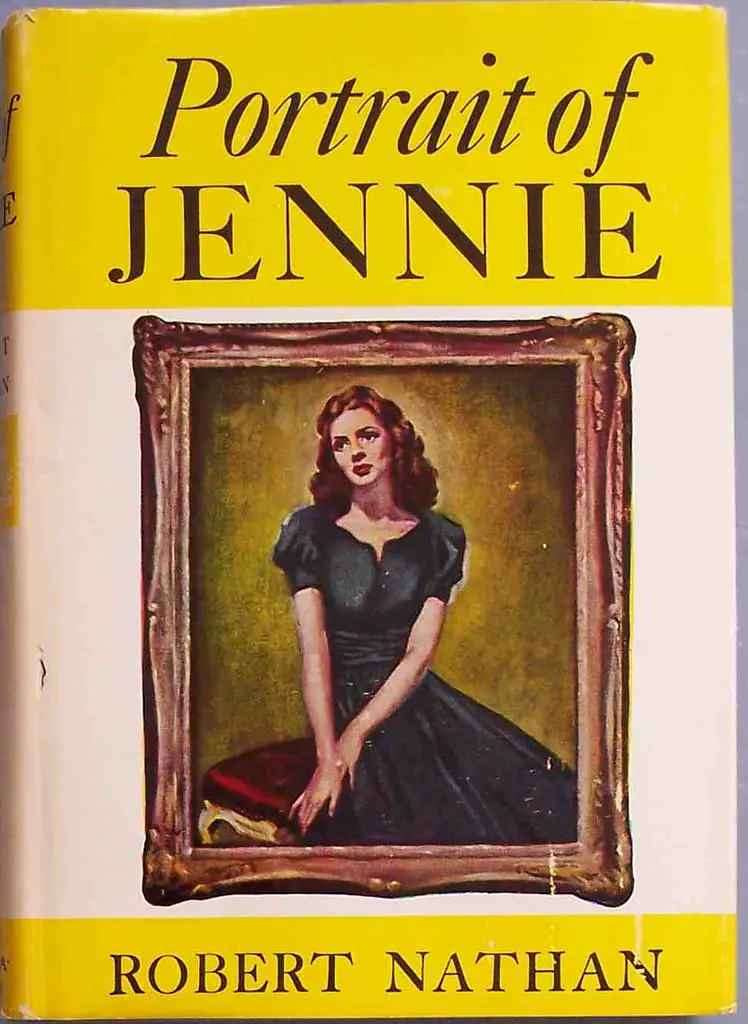
Where I come from
Nobody Knows;
And where I’m going
Everything goes.
The wind blows,
The sea flows –
And nobody knows.
Jennie makes an unusual request of Eben. “I wish you’d wait for me to grow up,” and then she departs.
Eben takes his sketches of Jennie to an art store, where proprietors Mr. Matthews and Miss Spinney buy the works. His career and fortune take a turn for the better, with his first assignment a mural of a picnic scene over a bar. At the same time, Jennie returns, in and out of his life at will, aging every time he sees her. She appears timeless, and as Eben reflects, “not of today.”
A bookseller tells Eben, “Do a great portrait and I’ll make you famous.” And that is exactly what Eben does. He paints Jennie in a black dress. Enchantment, two people in love caught between time and change, takes over the narrative. None of the traditional rules of time travel are in place here. Eben cannot summon her to him, ever. Jennie states on one of her journeys to him, “I can only come to you.”
In the novel, people see Jennie in person. We know she is real. When Eben loses her in a horrendous storm at sea that took place years before, the reader understands that this event is not the end or even the beginning. Time is neither here nor there. Jennie says, “How beautiful the world is, Eben, whether we lived now or long ago.” The couple believes “We’ll always be together somewhere.” The past isn’t behind them but all around them. The theme is clear and rather unique: Because they find and enrich each other, they serve to immortalize the one they love, Eben as a renowned painter and Jennie forever enshrined as his muse.
Portrait of Jennie – The Film (Joseph Cotten, Jennifer Jones, Director David O. Selznick, 1948)
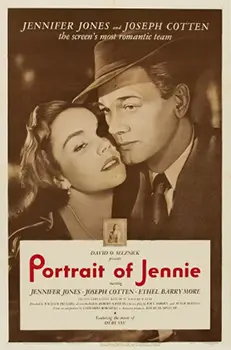
Filmed in black and white against a backdrop of shadows, silhouettes, and dark cloudy weather, this movie follows the novel about Jennie and Eben quite closely with a few differences. Nobody ever sees Jennie in the film, so she might be a figment of his imagination. Foreshadowing occurs in the mural Eben paints when his friend, Gus, a taxi driver, points to a woman pictured and says that she appears “drowned.”
The romantic vision intensifies with the musical score by Claude Debussy, the otherworldly Afternoon of a Faun. More emphatic declarations of love are made. In a disastrous storm on Cape Cod, Massachusetts, with gales and waves that seem to come “from far away,” Eben finds Jennie adrift and tries to hold on to her hand. But Jennie says, “You’re fighting nothing, Eben, nothing. You must live on.”
Most evocative is Miss Spinney’s declaration that one’s truth is what one believes, and that’s all that matters. Three young women view “The Portrait of Jennie” in the Met, and one says, “She was real to him or she wouldn’t look so alive.” Hauntingly astute.
Somewhere in Time (Richard Matheson, 1975)
Note: Somewhere in Time was originally titled Bid Time Return
O call back yesterdays,
bid time return.
— Richard II, Act III, Sc. 2 (Shakespeare)
Again, we are told upfront by the protagonist’s brother, Robert Collier, that he has published an edited version of his deceased brother’s journal of a spectacular love story that the man believed to be true. The essence of that story became the novel.
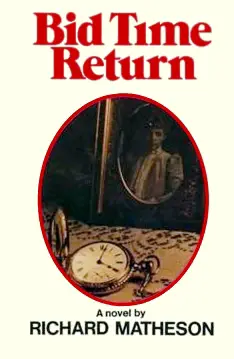
When 36-year-old Los Angeles screenwriter Richard Collier receives a death sentence medical diagnosis—an inoperable brain tumor—he reassesses what he wants to do with the remainder of his life. He flips a penny and through sheer fortune, he drives to the seaside Hotel del Coronado near San Diego, the site that initiates the time travel.
Built in the 1880s, the hotel’s connections to the past make it a character unto itself. In the hotel’s Hall of History, Collier is drawn to a photograph of an exquisite American actress, Elise McKenna, who performed at the hotel in the 1880s, including the role of Peter Pan, the boy who never grows up. Collier views the portrait for hours on end and falls in love with her, embarking on a quest to find out everything about her and when and if their lives had ever intersected.
Collier reads a book called Man and Time, which instructs him to perform mental exercises to eliminate the present from the past in his brain. He buys clothes from the era he wants to enter, lies on a bed at the hotel, and writes hundreds of times that it is Nov. 19, 1886, and that he must return there. Time flickers as Collier transports himself to the past.
When Collier and Elise meet, she asks, “Is it you?” He answers, “Yes.” Over time, we learn that this pair has experienced love through more than one lifetime. She reveals that two psychics told her about a mystery man she would one day encounter. In a book he had previously read about Elise, Collier learned that after an “incident” in her life, she had become a recluse. And Collier recalls that when he was 19 and in college, an older woman had spoken three words to him at a party he attended. That woman was Elise. He now knows that she died of a heart attack that same night. They had once actually overlapped in real-time.
Richard retains his thoughts and knowledge of his own time, which is disconcerting and does not bode well. But he reasons, “An invader of this time, I will, bit by bit, be covered by a self-protecting—and absorbing coat, to be gradually encapsulated. Eventually, the grain of me will be so layered over by this period that I will be somebody else, forgetting my source, and living as a man of this period.” He envisions Nature as the source of adjustment for any mistakes made by time travelers. “The flow of historical incidence is never altered more than temporarily by anyone who circumvents time. The reason, then, no traveler has ever returned from this bourn is that it is, of natural necessity, a one-way trip.”
Sadly, the unspoken rule of time travel where the past and present collide comes to pass. That “bad penny” that we speak of from the present turns up and transports him back to his prior existence with dire consequences.
Somewhere in Time – The Film (Christopher Reeve, Jane Seymour, screenplay by the novel’s author, Richard Matheson, Director Jeannot Szwarc, 1980)
Somewhere in Time was filmed at The Grand Hotel on Mackinac Island in Michigan. The time of the movie differs in that it is set in 1912 rather than the novel’s 1886. Elegant music, Rhapsody on a Theme of Paganini by John Barry (an adaptation of works by Paganini and Rachmaninoff) underscores each scene.
Extraneous characters have been removed from the film to let the lovers’ story dominate within the shadow of the actress’s sinister manager who tries to keep Collier from Elise, even arranging for thugs to capture him. In this time travel tale, Collier retains his knowledge from the present, which bodes ill for his desired permanent melding into the past with Elise. He and Elise make passionate love, yet the discovery of a 1971 penny in his coat pocket pulls him back into the present from which he cannot return. He does not die from a brain tumor but from a broken heart.
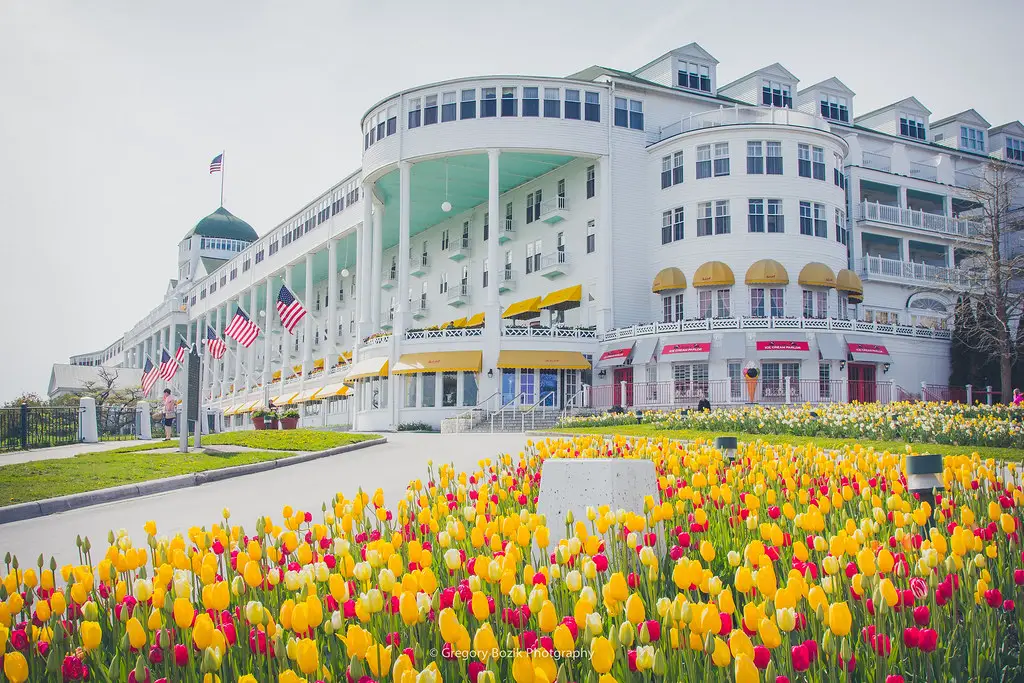
The film was not a commercial success. Yet on its rediscovery, so taken was the audience with the stars and the grandiose story, that in 1990 a fan club was formed: INSITE (International Network of Somewhere in Time Enthusiasts) by Bill Shepard to honor it. A plaque stands on the grounds of the Grand Hotel where the couple supposedly first met. For over 30 years, INSITE has gathered for a weekend at the Grand Hotel, a tradition scheduled to occur from Oct. 7 to 9, 2022. The film and its lovers have made a lasting impression over time, from the past to the present day.
Love After Death
Our doomed romantic pairs have options without end. Eben understands that time will reunite him and Jennie, somewhere, somehow. Richard and Elise will find each other in death and reach the light. These stories parallel the timeless legend of forbidden love between Tristan and Isolde. Vines and roses intertwine on their graves to bind them together eternally. French poet Pierre Dalle Nogare wrote in his 1977 play about them, “It can happen that love and death are a single word for two people: thus it was for Tristan and Isolde, who came into this world to recognize and name each other and to lose themselves in each other.” Some loves can never be separated or put asunder, however long time takes to work its magic. Believe it.
